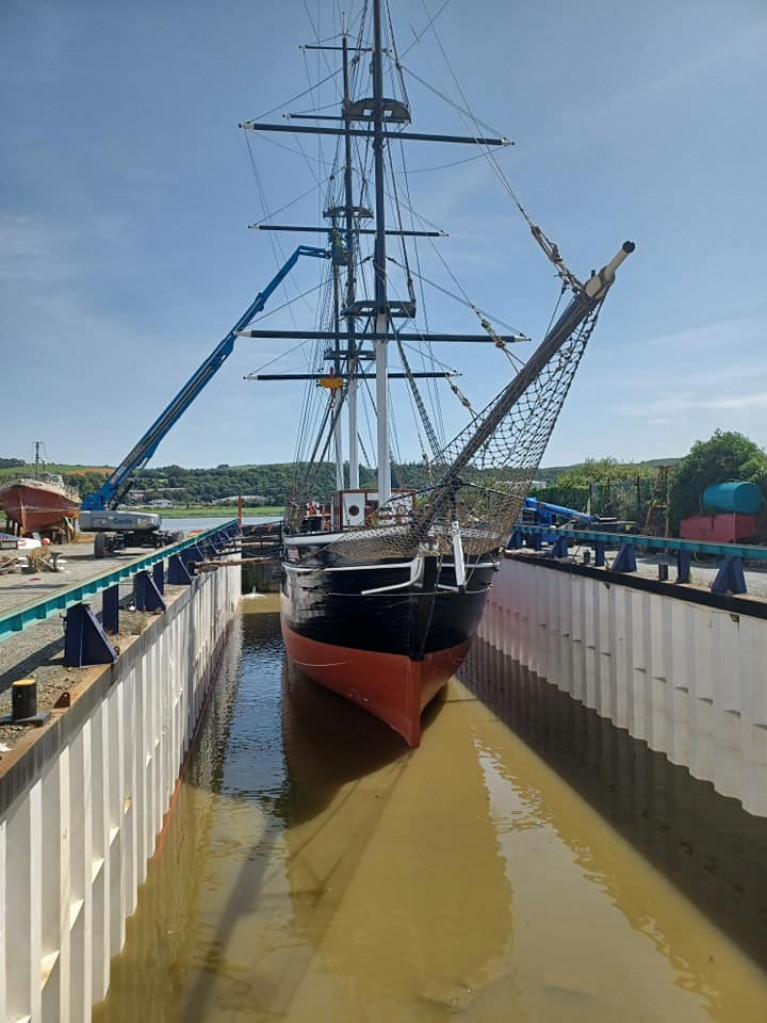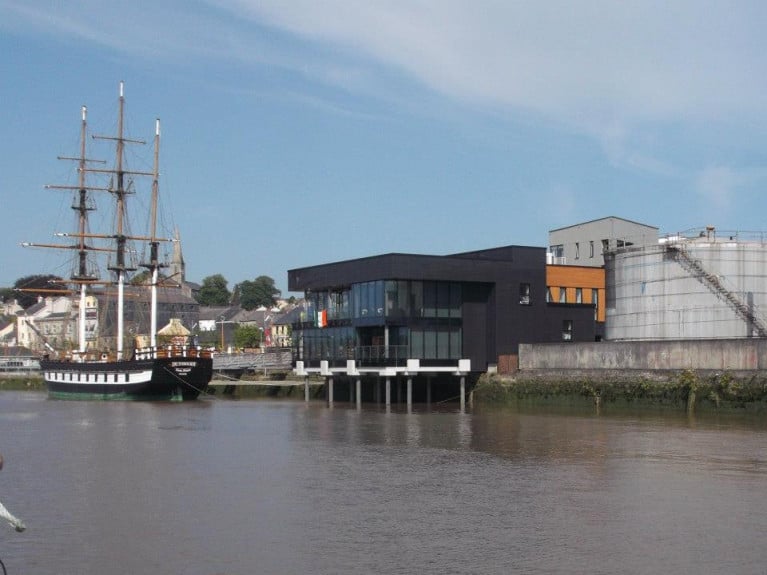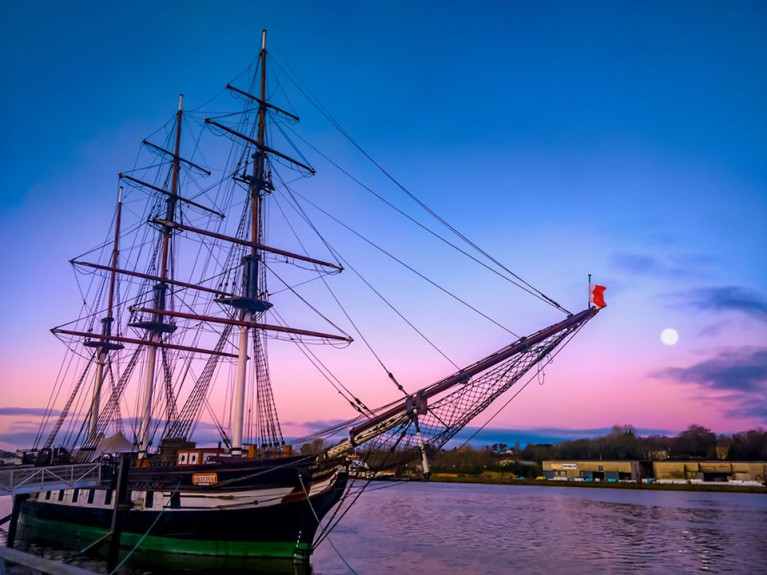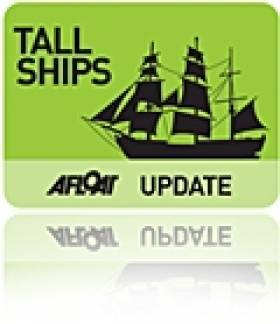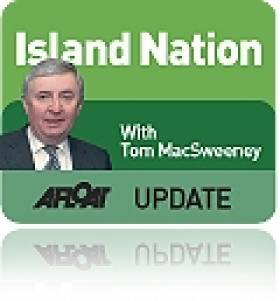Displaying items by tag: Dunbrody
Captain Tom McCarthy paid a visit to New Ross, Co. Wexford, to admire the newly refurbished tallship which he had previously sailed on its voyage to Pembroke, south Wales.
The visit as The New Ross Standard reports, was an opportunity to meet old friends, among them Frances Ryan, John F. Kennedy Trust Chairperson, Sean Connick CEO, and former harbourmaster Luke Foley.
Holding the unique distinction of being the only person to captain all of Ireland’s tall ships – the Dunbrody, the Jeanie Johnston and the Asgard II – the Corkman previously sailed the 'Jeanie' to North America during its tour there in the early 2000s.
The tallship's return follows an extensive break at (the nearby New Ross Boatyard) where it received a complete renovation, and now the Dunbrody is welcoming visitors once more, much to Seán’s delight.
‘We had our first tour bus arrive yesterday since March 2020, Trafalgar tours, and we’re due to have a couple more tomorrow,’ he said. ‘It’s a good sign, it’s wonderful to see it, but obviously because of restrictions we’re operating at reduced capacity and can only do outdoor tours at the moment'.
He added 'Currently we’re at 25-30 per cent of capacity but it’s a step back towards normality. At the moment we’re really looking forward to 2022 and preparing for a full tourist season.’
Dunbrody's Dawn Departure for €700,000 Dry Dock Makeover
The tallship Dunbrody Famine Ship was brought by tug across the Barrow last Monday to New Ross Boat Yard to go into dry dock for three months, during which time she will have extensive works carried out.
Work began on removing the (20 year old replica) vessel and the gangways from 5 a.m.
A crane was used to lift the gangway onto a truck and to disengage the rollers from the piles, prior to a tug bringing her safely across the river on a high tide, where she slipped into dry dock at 8 a.m.
Preparatory work was carried out over the previous fortnight.
Dunbrody Experience Visitor Centre CEO Sean Connick thanked local boat owners and New Ross Boat Yard staff for their work, along with Tom Byrne and John Dimond.
Further reading from the New Ross Standard here.
Emigrant Tall Ship Dunbrody Wins CIE Merit Award
An Award of Excellence has been won by the Dubrody Emigrant Ship for attaining a rating of 92 per cent+ from its clients.
The tallship at the Dunbrody Experience visitor centre, reports Wexford People, was one of 71 tourist attractions and hotels who achieved a merit award. These ratings as announced at the CIE Tours International 30th Annual Awards of Excellence are evaluated independently and externally.
Speaking at the presentation of CIE Tours International Annual Awards of Excellence Elizabeth Crabill said; '30 years ago CIE Tours International introduced its annual Awards of Excellence to recognise Ireland's hospitality ambassadors - the people and businesses throughout the country who put Irish tourism on the global stage through the warmth of welcome and quality of service provided to our international visitors.
Click here fo the rest of the story.
The Return of the 'Wexford' Tall-Ship
A grant of €1m from Fáilte Ireland was allocated towards the cost of the refit as part of the National Development Plan (NDP). Visitors can now take guided tours of the floating tourist attraction though access to the shoreside visitor centre remains closed due to an upgrade. Work on an extension of a new exhibition centre is expected to be completed in May or June.
Dunbrody is a full scale reconstruction of the 19th century replica famine-ship based on the vessel built in 1845 in Quebec, Canada for the Graves family of New Ross. Ireland's most inland port being made famous with the visit of President John F. Kennedy in 1963 to the same quayside where Dunbrody is berthed.
To date the Dunbrody's presence outside her homeport has been scarce. During the Waterford Tall Ships Festival in 2005 she took part in a memorable and historic 'Parade of Sail' where she formed as part of the trio of Irish tall ships that met together for the only time. The sailing spectacle of the international fleet was headed firstly by the Irish trio with Asgard II leading followed by Dunbrody and astern the Jeanie Johnston.
In the following year Dunbrody made her maiden and only international voyage to Milford Haven in south Wales. The Pembrokeshire estuary had hosted the new festival, Seafair Haven. On that occasion she had the honour of leading another parade of sail, under the command of Captain Tom McCarthy.
Dunbrody was last dry-docked in 2006 and also at the New Ross boatyard which lies on the Co. Kilkenny side of the riverbank. The 176 foot / 54 metre barque was built in 2001 and was last vessel completed at the boatyard. During her building the public could access the yard and the construction process could be viewed from above at a gallery set within the covered building hall.
The structure no longer exists but which was built originally for the Ross Company boatyard during the 1970's. The yard specialised in building barge pontoons for markets in the North Sea until the premises closed in the 1980's. In recent years and under new management the dry-dock (75m X 15m) has been upgraded with a new gate and pump.
Looking for further reading on Tall Ships in Ireland? Click the links below:
Click this link to read all our Tall Ships Stories on one handy page
Previewing Ireland's Tall Ships 2011 Season
Can Ireland Get a New Tall Ship?
- Asgard II
- Jeanie Johnston
- river barrow
- New Ross
- River Suir
- Milford Haven
- Ports and Shipping News
- barque
- Fáilte Ireland
- Dunbrody
- Parade of Sail
- Brigantine
- Waterford Tall Ships Festival
- Dunbrody Heritage Centre
- River Nore
- New Ross Boat Yard
- Sea Haven
- National Development Plan
- NDP
- President John F. Kennedy
- Capt. Tom McCarthy
- Ross Company
- Seafair Haven
Now There is None
What a magnificent sight it was as the three Tall Ships, each flying the Tricolour, headed the fleet of the gracious ships of sail from all over the world.
How different it will be in July when the world's Tall Ships again parade down the Suir. There will be no Irish national sailing ship to lead the parade. A number of private Irish entries are expected at Waterford from June 30–July 3 amongst the 70 vessels from around the world when the city has the honour starting the race. In 2005 about half-a-million people visited the city while the Tall Ships were there.
The lack of a national tall ship is another example of governmental maritime neglect, directly due to the decision of former Defence Minister Willie O'Dea, T.D. After the sinking of ASGARD he publicly committed the Government to its replacement, but after receiving insurance compensation money for its loss, he put the money into coffers of the Department of Finance and closed down the national sail training programme. There was a big difference between what he promised and what he did, a disregard for the maritime sphere which it is hard to forgive. I also recall how former Taoiseach Bertie Ahern did not visit Waterford during the 2005 race, when it was the biggest tourist event in the country. When I broadcast my report expressing astonishment at this snub government sources and Fianna Fail didn't like it. Truth in the news can be painful!
The organisers made contacts about the DUNBRODY, which continues to earn income at the New Ross quayside where it is moored as a tourist attraction and with the JEANIE JOHNSTON, moored at the Dublin Docklands.
However, neither will be taking part, the organisers have confirmed, tough they said that it was expected that about 100 young Irish trainees would sail aboard tall ships in the race, half of them with funding support from local authority, business and other sources. A group of Irish sailors have also indicated they are making arrangements to charter a UK-registered vessel the JOHANNA LUCRETIA for the event.
Once again the Irish Government has sunk to the bottom where maritime matters are concerned.
It was announced this week in Waterford that Fáilte Ireland has made a significant financial and marketing commitment to this year's event, though the financial figure was not disclosed .A free festival programme will feature street acts; comedy; international and home-grown artists, nightly fireworks, an artisan food village and an atmosphere which the organisers say "will thrill people of all ages and nationalities."
• This article is reprinted by permission of the EVENING ECHO newspaper, Cork, where Tom MacSweeney writes maritime columns twice weekly. Evening Echo website: www.eecho.ie


























